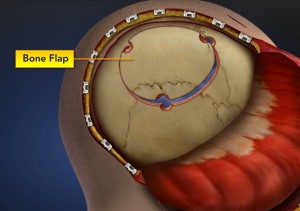Craniotomy – Craniectomy Essential Brain Surgery
Taking Out Part of Skull in Craniotomy
By Gordon S. Johnson, Jr.
A craniotomy and craniectomy are both types of brain surgery that involve removing a bone flap.The size of the bone flap depends on the extent of the neurosurgery being performed.

As shown, in a Craniotomy, the neurosurgeon removes a piece of the skull, the bone flap, in order to perform surgery inside the brain to relieve ICP.
In a craniotomy or craniectomy, the surgeon removes a piece of the skull – the bone flap – in order to perform surgery inside the brain.
Craniotomy
This type of surgery involves taking out a bone flap, but the piece is replaced at the end of the surgery. In a craniotomy, the bone flap is replaced at the end of the surgery. Complications from these procedures may involve seizures. Anticonvulsants are given seven days after the procedure. Another possible problem resulting from surgery is bacterial meningitis. Pain is also a problem with these procedures, which may be managed using scalp infiltration, nerve scalp blocks, or morphine.
Craniectomy
A craniectomy is similar to a craniotomy, but the bone flap is removed permanently or replaced during a second surgery. This is done to let the brain swelling go down and reduce intracranial pressure.
The bone flap can be replaced at a later date when the brain returns to a normal state of health. Sometimes plates or artificial bone may be needed to reconstruct the skull. It is possible that there may be defects or gaps in the skull when the skull does not totally fuse.